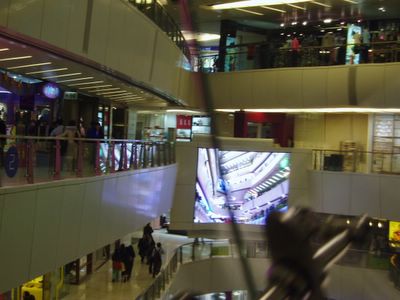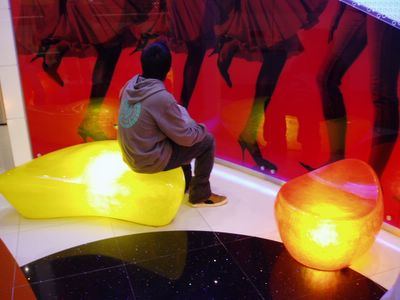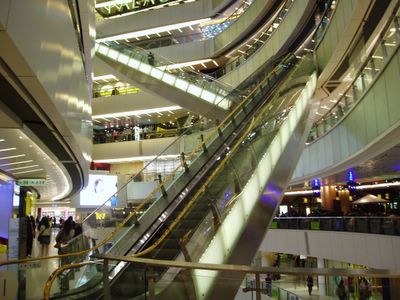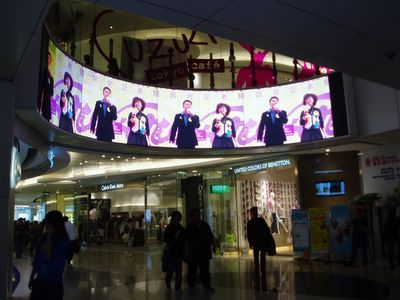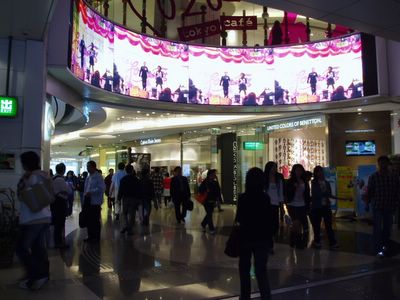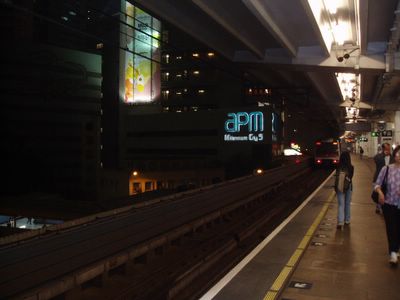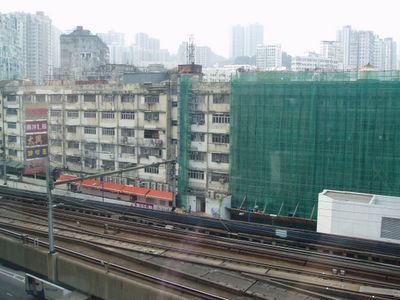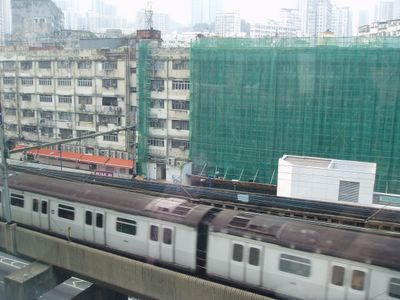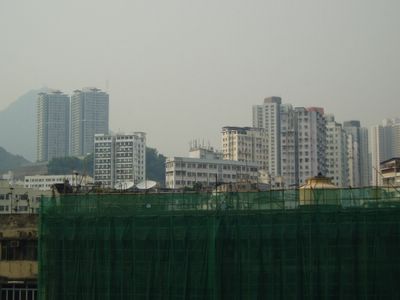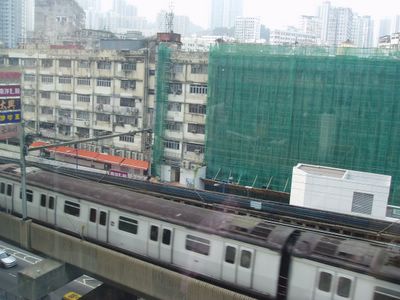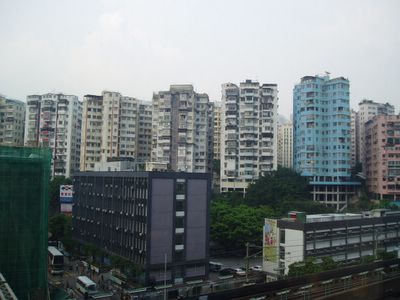city culture assignment 4
With the development of APM, the land use and the mode of consumption of Kwun Tong changed. At the beginning, Kwun Tong was an old district, crowd of people and there were many industries located near Kwun Tong MTR station. There was not much space could keep people for a longer time. However, APM seems breaking down the traditional mode of shopping habits and changed the consumer behavior such as duration of consumption, frequency of consumption. Shopping in APM became a combination of shopping, commercial activities and omni lifestyle. It also gives shoppers surprise, entertainment through the design and the activities they hold.
In this project, we have interviewed several youngsters so as to find out how they consume APM. Besides, we have analyzed the construction of APM through its slogan, architecture, facilities and activities they hold etc, to know the changes of consumer culture. At last, we will analyze the difference between people’s experience and the representation of media to APM.
THE CONSTRUCTION OF APM
Nowadays, the function of shopping mall has been changed; shopping mall is no longer a place for us to consume goods, but also appreciating art work, relaxing and receiving information. We have done observations in APM three times and searched information about APM on website; we found that people go to APM for different purposes.
For the elderly, APM is a place for them to spend time, but in a different way. We saw some old people staying in the food court reading newspapers, while some of them just sit on the bench which located on different floors. They also clustered in the t:>> park and chat with other elderly. APM became a place for them to connect with other people, and strength their social bonding.
For youngsters, they could also see APM as a place for spending time. As what we observed during weekdays, many students went window shopping in APM, or they gathered in the t:>>park to chat after school. Since APM closes lately, they may even stay in APM even at the late mid-night in hot summer. Some students even did their revision in the t:>> park, or went there to watch performance and exhibitions. From our interviews, nearly no respondents told us they went APM only for shopping, but they said they went there to eat, to join friends or “hea”!
Actually there are also some places which are especially decorated for youngster such as Xsite. Xsite is an open shop front design and special multi-colored replaceable plastic flooring will be used to create fresh looks from time to time. All these will make APM an attractive spot for shoppers.” (APM website, 2005) Xsite is a creative showpiece of contemporary architecture. Besides, various activities are held in every public holiday such as singing concert, fashion shows etc. In fact, unlike other shopping centers, APM did not divide the shops into different levels. In other words, we can see restaurants, jewelry shops, bakery, and ladies sections in the same level. It seems hybrid, but this is one of the themes in APM, which is not restricted by the shop allocation. APM is establishing unique “Omni-Lifestyle magazine” retail concept in the mall, which can get newest and friendliest entertainment without time limitation just like reading a magazine.
We can see that the spatial setting and the activities they hold seems constructing the mode of consumption and the rhythm of consuming. People stay longer in the shopping mall and they are trying to buying stuff at one time.
ADVERTISEMENT
Advertisements aim to promote the goods and service by various channels. Media is one of the powerful tools for advertising as it helps to sustain and concentrate a set of images through constructing and representing the images. Kilbourne gave us an idea that advertisements show some products, especially those luxuries, have symbolic meanings behind. These products helped people who consume it to achieve a different lifestyles or aspiration. They could also gain something which money cannot buy, like youth, beauty and even good relationship with the others etc. (Kilbourne, 2004)
In the case of APM, the media and the physical existence of APM helped a lot on representing and constructing its own image. We found numerous advertisements showing on advertisements boards in the MTR, body of their shuttle bus, television, magazines and also the Sun Hung Kei club booklet about 3 months before its opening. Just like APM’s billboard in Kwai Fong, it shows that the girl dresses fashionably, the sharp color attract youngsters a lot as fashionable and trendy things are what youngsters usually pursue. These young people were actually consuming the symbolic meaning of APM but not just the place itself. Through creating meaning, more youngsters would be attracted to consume there. Besides, APM has selected several specific magazines when they are posting the ads since the concept of magazines are similar as the concept of APM which are omni-lifestyle magazines. Most youngsters would like to consumer the above magazines as they mainly report in-fashion stuff such as clothes, accessories and places that youngsters would like to go.
From ads’ analysis, it emphasizes on creating a new shopping mode which was no time limitation on consumption and omni-lifestyle retailing concept. Because of this, we have interviewed five youngsters in APM so as to know how the frequency of using APM, the importance of APM to them and how ads affect people consumer behavior. In the interview, we have asked about their experience in APM and found that although some of them see APM advertisements, interviewees didn’t think that advertisements affect their consumer behavior. In those interviews, they all agree that APM provide a place for them to buy various stuff at the same time. More importantly, they have a new place to gather maybe even a place for study.
Some interviewees mentioned that they have gone to APM at midnight, however, many shops are closed and it seemed not match with playing at AM and PM which is proposing from slogan. They thought that advertisement is not important to attract them to go APM.
From the above interviews, people’s experience in APM seemed not totally consistence to the media’s presentations. People not just go there to enjoy its omni-life style, they consume there also for the meaning behind. Just take interview one as an example, interviewee’s response was that, she did not like to shop there because the things there are too expensive. A shopping mall to a young people with low purchasing power maybe a place to buy cheap things while APM could only for her to do window shopping.
FURTHER QUESTIONS:
We have learnt so much about the media, someone said the media would affect people’s buying behavior, like buying “useless” things, consume more about the image but the product itself. However, in the interviews with people who visit APM, they seemed not affected by the media so much. Some respondents said the first time that they visit APM may because of the media, however, the others was just their choice. So, how would the media affect people to visit the mall? And how people use tactics to prevent the affections of media
Besides, the new kind of shopping method gave consumers a convenience and comfortable shopping environment. An air-conditioned, one-station shopping method helps consumer to shop faster. The duration of consumption became shorter. It seemed saved time for both the consumers and the sellers. However, when we look more in depth, the new shopping method is actually diminishing the chance for social contact among people.
We can easily expected that, people will not bargain or chat with the salespersons in APM, while they will do that with those small stores or the shops that they used to visit. The bargaining and chatting process help people to get closer. At least, they would have a chance to communicate with others. Remember the TV dramas showing the relationship between neighbors were very close. In the older districts nowadays, this still exist. Just like the herb tea shop that we visited in Kwun Tong, the salespersons were just so nice that even give us an egg to eat. We saw them chat with the buyers and sometimes say hello to the people that passed by.
These are what we can never see in a shopping mall. The social ties cannot replace just by proving a more comfortable shopping mall like APM. We thing that, if Kwun Tong continue to develop, the ties would easily break down in the future. Would Kwun Tong people treasure these ties? How would they prefer to have a better development?
CONCLUSION
After studying APM’s establishment, we have deeper understanding about Kwun Tong. It seemed that many Kwun Tong young people love to see the changes of the place. They think Kwun Tong could not provide them enough facilities for leisure. However, in our point of view, we would like Kwun Tong to maintain its “tradition”—a strong social tie. Shopping malls are already too much in Hong Kong.

